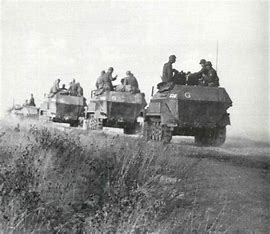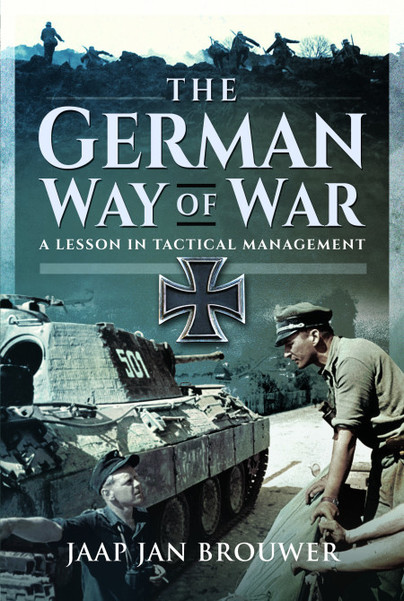Author Guest Post: Jaap Jan Brouwer
THEN AND NOW: DID THE SOVIET UNION PLAN A ‘SPECIAL MILITARY OPERATION’ AGAINST GERMANY IN 1941?
There is much resemblance between the Second World War and the Russian/Ukraine war of today. For instance the way the Soviets planned their war and the guaranteed they sought. The Soviets had been preparing for war with the west for a long time because the west was the enemy of communism.
Learn more about the historical dimensions in my book ‘The German way of war. A lesson in tactical management’ and in ‘The German way of war on the Eastern Front 1941 – 1943’(release date October).

The preparations of the Soviets
We have seen that the Soviets had been preparing for conflict for a long time. Their economy was in fact a war economy from the time of the first Five Year Plan in 1928, and a further acceleration of arms production was planned in the third Five Year Plan for the period 1938–1943
The Winter War with Finland made the Soviets realize the importance of tanks of the KV-1, KV-2 type, as well as the later T-34. Military expenditure rose from 25.6 per cent of gross national product in 1939 to 32.6 per cent in 1940 and 43.4 per cent in 1942. The Soviets had already built up an impressive arsenal before 1939, which was supplemented in the following years with no fewer than 17,000 aircraft, 7,600 tanks, 80,000 artillery pieces and mortars, and more than 200,000 machine guns and automatic weapons.
About 20 per cent of the Soviet equipment was obsolete, while 80 per cent was new, including designs superior to anything the Germans could field. All in all, given the planned growth of armaments and the modernization of weapon systems, the question was whether and how the German Army after 1943 could ever have resisted the superior numbers of men and weapons that the Soviets could field. In other words, in the light of the actual and planned build-up and modernization of the Red Army, combined with the expansionist ambitions of Soviet communism, Operation Barbarossa can in retrospect be regarded as an unplanned ‘pre-emptive strike’ by the Germans. Even as it was, the Germans were unpleasantly surprised by, for example, the presence of tanks such as the T-34 and KV-1 and -2. Had they waited three years, and had the Soviets had time to fulfil all the objectives of the Five Year Plan, the German Army would probably have been overwhelmed.
The Soviets themselves were also planning to strike first, as is apparent from their planning in 1940 and 1941, but developments on the German side forced the Soviets to turn their ambitions into actual plans ahead of schedule. So on 14 October 1940, a first variant of the eventual 1941 Soviet strategy was drawn up. This was developed into a draft dated 15 May 1941 entitled ‘Considerations on the Plan for the Strategic Deployment of the Armed Forces of the Soviet Union in the Event of a War with Germany and its Allies’. An important section of this plan concerns the troop build-up on the German side: [Germany] has the opportunity to get ahead of us and deal [us] a sudden blow. In order to prevent this, I [Stalin] consider it necessary to leave the initiative under no circumstances to the German command, to be ahead of the adversary and to attack the German Army when it is at the stage of deployment and still will not be able to form a front combining all the units they can deploy … The first strategic objective of the actions of the Red Army is to destruct the main body of the German Army deployed south of the Brest-Demblin line. In line with this strategy, the document goes on to say: ‘In such a way, the Red Army will start offensive operations from the Cizev-Ljutovisko front with a force of 152 divisions against 100 German ones. Active defence is proposed at the rest of the state border.’ The document then states that covert mobilization and concentration of troops at the borders are necessary to achieve surprise. All in all, it can be seen as the blueprint for a Soviet ‘pre-emptive strike’, which was to promote the longer-term ambitions of international communism. Little wonder that many of the Soviet troops were, much to the surprise of the Germans, within 200km of the border. The document was discussed with Stalin on 24 May 1941 at a top-secret meeting with civilian and military leaders. In line with this, more and more troops were concentrated on the western frontier. The 77 divisions already present were supplemented by a further 114 from the ‘first strategic echelon’. It was planned that after the mobilization of 802,000 men of the Sixteenth, Nineteenth, Twentieth, Twenty-second, Twenty-fourth, Twent-fifth and Twenty-eighth Armies, this ‘second strategic echelon, would be transferred to the west on 10 July. Ammunition dumps and hospitals were built, and 7,113 aircraft were stationed at forward airfields near the border. Given the offensive nature of their deployment, these units did not build defensive fortifications or obstacles; there were no explosives prepared to destroy bridges, and railways were not undermined: all signs that the Soviet army was preparing itself not for a defensive war but for an offensive. At the border, 1,320 goods trains were ready to leave for the west, and on the last day before Barbarossa, no fewer than 47,000 wagons with war materiel were on their way to or had just arrived in the border area. It was no wonder that the Soviets lost nearly 85 per cent of their supplies in the early weeks of the war.
Some factories had already been dismantled. In the weeks and months preceding the German attack, 2,593 industrial enterprises were moved eastwards in approximately 1.6m railway cars, mainly to the Urals and Siberia. Workers, sometimes with their families, were also evacuated. A total of 18m people were resettled in this way. (7 : 77) These relocations were necessary because 75 per cent of Soviet war industry was located around the threatened cities of Moscow, Leningrad and Kiev. In accordance with the Military Economic Plan of August 1941, the east of the Soviet Union was to become the new industrial base. This plan would set the framework for all industrial activities in the coming war years. It was not exactly new: the first Five Year Plan already stipulated that large parts of Soviet industry had to be relocated to the east for strategic reasons; but the German invasion accelerated this process dramatically. (32 : 262)
Agitprop
‘The Tasks of Political Propaganda in the Red Army in the Near Future’. This was the title of one of the eight directives adopted at various meetings of Russian newspaper and magazine editors in May 1941. They served to prepare minds for the coming war. Examples of the guidelines include: ‘To direct all forms of propaganda, agitation and education to the one goal of political, moral and military preparation … for the conduct of a just, offensive and all-destructive war’. ‘The increased political, economic and military power of the Soviet Union enables us to pursue an offensive foreign policy, to decisively eliminate war zones at our borders by expanding our territory … (sounds familiar..JJB) The possibility exists that the USSR will be forced to act in view of the situation that has arisen and has to take the initiative and proceed to offensive military actions.’ Furthermore, it was realized that there was no point in a defensive posture, so ‘against Germany we must apply the same offensive strategy, supported by powerful equipment.’ In the eyes of the Central Committee, the time was perhaps favorable for pushing forward the frontiers of communism. The German occupation of much of the continent and growing discontent among the German population, a protracted, hopeless war with Great Britain, a fragmentation of the Wehrmacht over several fronts, an impending Japanese-American conflict and its repercussions for Germany: everything indicated that now was a good time to strike.
Meanwhile the GROE (military intelligence service) was well aware of the German war plans, but had no idea of the exact time of the start of hostilities. Hess’s flight to Scotland on 10 May 1941 raised suspicions that there could be an agreement between Britain and Germany to act jointly against the Soviet Union. While in June it became increasingly clear that an attack was imminent, Stalin refused to put the Red Army on alert. The secret service saw to it that military commanders did not take defensive measures, and those who did were accused of causing a ‘panic mood’. On the night of 21/22 June, Stalin refused to give the order for a ‘military alarm’, because in his opinion it was too early. History would tell otherwise: the Germans launched their attack at 3.15 a.m. on 22 June. (7 : 43-55)

The German Way of War is available to order here.

